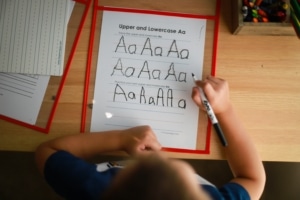The Power of the Pencil: Why Handwriting Still Matters
Handwriting plays an integral role in developing a child’s literacy skills.
In a digital world, it is easy to assume typing skills have replaced the need for handwriting. However, research tells a different story and demonstrates just how essential handwriting is for developing minds.
Handwriting Builds the Brain
Multiple studies show that handwriting is more than a motor task; it’s a cognitive workout. When children write by hand, they activate areas of the brain linked to thinking, memory, and language processing. A study using EEG scans revealed that handwriting promotes more neural connectivity than typing, which could help boost learning and retention.
Writing by Hand Supports Learning
Children who practice handwriting regularly tend to write more and write better. In fact, instruction in handwriting improves not only legibility but also the quality and quantity of written expression. Fluent handwriting frees up working memory to focus on content rather than letter formation.
When should kids start handwriting? Early Instruction Matters
Research suggests that introducing children to handwriting practice at an early age helps develop neural connections within the brain in relation to literacy and language. The more connections that are being made, the less difficult it is for children to become fluent readers and writers. Explicit teaching of letter formation, pencil grip, and paper placement leads to quicker mastery and better long-term fluency.
Handwriting vs. Typing: Which is more beneficial?
The concept of a child being able to write and having legible handwriting feels like a no-brainer, but, in our society today, so much of what a child learns is done through a computer. Wouldn’t it make more sense for a child to be more proficient at typing rather than writing? Ultimately, a child should be proficient in both so that they can have the best opportunity at academic success. However, studies show that typing activates less parts of the brain than writing, and as it was stated earlier in the post – the more neural connections being made while learning, the more likely a child is of retaining the information they are studying. Despite all of this, there are some benefits to typing that should be considered.
Benefits of Typing
- A faster option for note-taking and essential for using online databases for research
- Most academic settings, especially in higher education, require typed assignments and use of modern technology
- Increased productivity and promotes more efficient ability to multitask

At the end of the day, if a student is to be a good writer, then they should start with working on their handwriting rather than perfecting their typing skills.
Handwriting Tips for Parents: Helping Your Child Develop Confident, Legible Writing
Posture & Setup
- Sit with feet flat, back straight, and non-writing hand steadying the paper
- Use a slanted surface or slight clipboard tilt for better wrist control
- Paper should tilt slightly away from the writing hand
- Short pencils or grips like the “Grotto Grip” can help build proper hold
Pencil Grip
- Use a tripod grip: thumb and index finger pinch, middle finger supports

Practice Tips
- Keep sessions short and consistent (5–10 minutes daily)
- Start with tracing or copying letters, then move to writing from memory
- Encourage writing real things: notes, labels, thank-you cards
Letter Formation
- Teach letters in groups by stroke (e.g., c, o, a, d)
- Focus on starting points and consistent size
- Use dashed letters or highlighted lines to reinforce stroke order
Make It Fun!
- Use colored pencils, dry-erase boards, or sidewalk chalk
- Let them write to a friend or grandparent
- Try handwriting games like “Rainbow Writing” (trace the same letter with 3 colors)

Want help identifying handwriting challenges or strategies to support your child’s writing fluency? We’re here to help: from pencil to paper to progress.
Sources:
Graham, S. (2019). Want to improve children’s handwriting? Here’s how. American Federation of Teachers. https://www.aft.org/sites/default/files/graham.pdf
James, K. H. (2017). The importance of handwriting experience on the development of the literate brain. Current Directions in Psychological Science, 26(6), 502–508. https://doi.org/10.1177/0963721417709821






